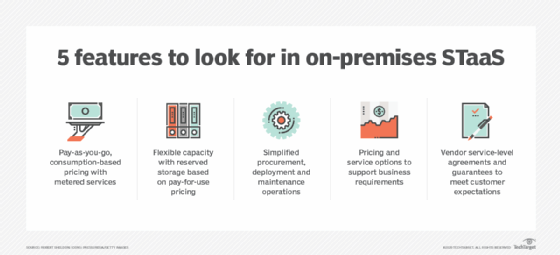
Getty Images/iStockphoto
Weigh these 6 enterprise benefits of storage as a service
Storage as a service offers cloud procurement and remote management of on-premises storage. Benefits include scalability, utilitylike consumption pricing and storage optimization.
Enterprises have realized the potential benefits of storage as a service. The idea is to let organizations buy storage in the same way they buy other cloud services.
Using service-based consumption, enterprises lease on-premises storage from a managed service provider (MSP), public cloud vendor or storage vendor. Customers select how much compute, networking and storage they need, and specify encryption and service levels for their applications. The vendor oversees planning and deployment; it can also manage the storage infrastructure on the customer's behalf.
AWS, Google Cloud Platform and Microsoft Azure public clouds enable users to scale storage and move data from local storage to a cloud archive. Most large storage vendors, such as Dell EMC, HPE and Pure Storage, have moved to selling all infrastructure -- including hardware arrays -- as services that integrate public cloud support.
DevOps organizations use storage as a service (STaaS) to keep pace with soaring data growth generated by modern cloud and edge applications.
Here are six advantages of using the cloud to procure and manage on-premises storage, as well as potential drawbacks to consider.
1. Avoid upfront capital expenditures
STaaS enables users to better rationalize storage spending. Organizations can buy capacity as needed via the cloud. Procurement and provisioning occur dynamically. Paying for storage by usage can turn it into an operational expense with predictable pricing, rather than a capital-intensive upfront cost.
2. Automate scalability
Storage consumed as a service allows data centers to flexibly scale capacity up or down as business needs change. Storage is pooled and made available to authorized users. Data is placed on solid-state media or HDDs according to an application's performance needs. Along with business agility, STaaS improves visibility into data and metadata, reduces data sprawl and aids infrastructure consolidation.
3. Eliminate complexities
Related to scalability, storage automation replaces manual tasks to manage, maintain and upgrade storage infrastructure. Storage teams thus can concentrate on issues of greater strategic importance to the business.
4. Improve capacity planning
Storage refresh planning is complex and time-consuming. The IT team maps out new hardware configurations, determines compute and network requirements, and vets competing storage products. The time from purchase to delivery and deployment of new storage hardware often spans several weeks, perhaps months. Conversely, acquiring storage as an on-demand cloud service enables admins to expand capacity quickly -- sometimes within hours.
5. Optimize storage management and service levels
Vendors offer STaaS subscriptions as fully managed or self-managed options. In both instances, the vendor sizes and installs the storage gear at the customer's data center or a co-location facility.
With the fully managed option, the MSP or storage vendor analyzes the customer's workloads to design storage that best serves application needs. The vendor can select the equipment and storage media, and then remotely manage the on-premises storage.

With the self-managed option, the customer handles day-to-day storage management. Organizations that must retain local control of data for business or compliance reasons often prefer this option.
6. Integrate and upgrade existing storage
Major storage vendors offer integrated cloud arrays that mirror the deployment and procurement model of top cloud providers. These hardware-based storage systems contain APIs for writing data to the public cloud. A partial list of storage vendor STaaS platforms includes the following:
- Dell Technologies Apex
- HPE GreenLake
- Hitachi Vantara STaaS
- IBM Storage as a Service
- NetApp Keystone
- Pure as-a-Service
Many storage vendors offer fixed service bundles to customers directly and through channel partners.
Possible drawbacks of STaaS
Not every organization will achieve the benefits of storage as a service. For now, larger organizations appear to be the most likely adopters. STaaS does not necessarily signal the demise of traditional networked storage. When budgeting and planning, consider the following issues:
- Cloud egress charges. Using the public cloud to migrate on-premises data has many advantages, but retrieving the data back to local storage incurs egress charges, which can add up on the monthly bill.
- Data protection. STaaS providers typically don't bundle backup and data protection in the monthly fee. Those tasks are the organization's responsibility and factor into any cost-benefit analysis.
- Minimum monthly commitments. Vendors usually require customers to purchase a set minimum of terabytes of storage per month. Make sure to understand the organization's current capacity needs and rate of data growth.
- Service levels and refresh costs. With cloud consumption, equipment-related costs are obscured from the end user. Ask for details on any subscription-based pricing increases and the vendor's contractual obligations regarding guaranteed service.






